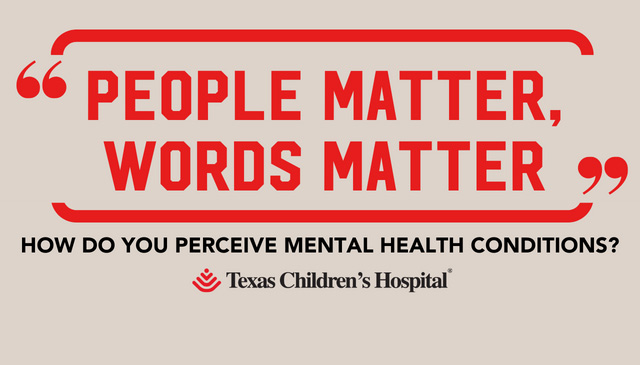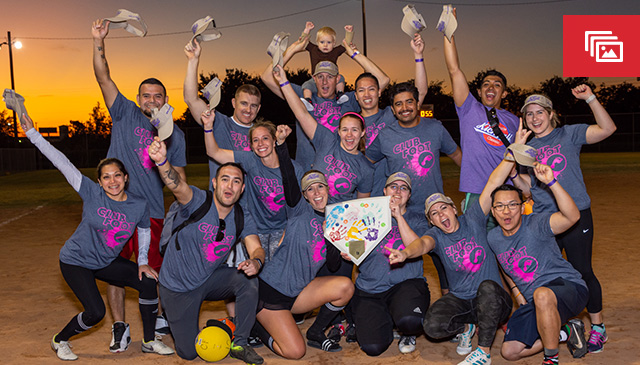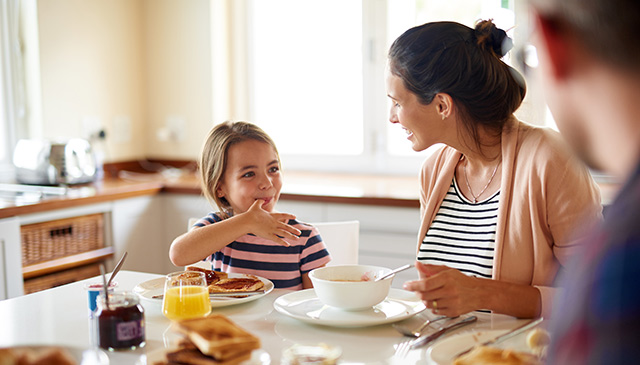
Finding the right words to say just got easier. Learn more about why perception around mental health matters and ways you can help reduce the stigma surrounding mental health. Read more

Finding the right words to say just got easier. Learn more about why perception around mental health matters and ways you can help reduce the stigma surrounding mental health. Read more

There’s a ton of excitement in the air as our family members, friends and neighbors return to school. Butterflies and anxiety, too – some because of the lingering effects of tragedy and concern about safety. Texas Children’s Behavioral Health experts, Dr. Karin Price and Dr. Kirti Saxena recently wrote a guide offering tips for managing back-to-school stress that can overshadow the importance of reconnecting, experiencing firsts and building resilience.
A few of their tried and true approaches for adults managing their own worries while helping children manage theirs include:
Managing your own feelings first. Children often take cues about how to respond to situations from their caregivers. That’s why it’s important for adults to model flexibility and acceptance of things beyond our control and avoid negative talk as much as possible. This can make it easier for kids to feel confident and brave about returning to school.
Listen when your kids are not talking. Kids’ nonverbal cues can speak loudly – difficulty sleeping, changes in appetite and physical aches and pains are some of the things that may be signs of worries they haven’t figured out how to talk about yet.
Model coping behavior. Parents and caregivers can help children learn to handle difficult situations by helping them to label their feelings. For example, saying things like: “It sounds like you are feeling worried about going back to school.” You can acknowledge that the situation is stressful, while also helping your child understand they are brave and can handle hard things by saying something like: “Lots of kids and families are feeling nervous about going back to school. It may be hard, but I know you can handle it because you are a brave kid who can do hard things. I am here to help you be brave.”
Drs. Price and Saxena encourage parents to seek professional help if their child’s anxiety about returning to school is ongoing, intense, or causes enduring issues with friends, school or family life.
You can find their full guide here for more tips to help you provide comfort and raise healthy, resilient children.

Now is the time to kick start your involvement in the annual Periwinkle Kickball Classic, which helps fund Periwinkle Foundation camps, arts and survivor programs for children, teens, and families affected by cancer and other life-threatening illnesses.
This year’s one-day tournament will be held Saturday, October 1, at Westbury Little League. Anyone age 14 or older is eligible to play. Rally with your co-workers, friends, families and neighbors to build teams of 10 (minimum 5 women) for this fun-filled event. Each team must raise at least $500 to enter.
Get kicking with your department now to form your team, register and start practicing! You will have the opportunity to select one of two divisions when you register:
Just for Fun – teams play in two round-robin games in the morning and do not participate in the playoffs. You are welcome to stay the rest of the day to cheer on teams in the competitive league.
In It to Win It – competitive teams participate in a double elimination tournament. Each team is guaranteed to play at least two games. Teams are encouraged to recruit 12-15 players to sub throughout the tournament. Keeping with tradition, a Texas Children’s bracket will be formed for our teams to compete to win the Texas Children’s 2022 Periwinkle Kickball Classic championship.
Contact Texas Children’s Pediatrics Sugar Land Physician Dr. Hubert Ho with any at questions about the tournament at hyho@texaschildrens.org.
Learn more about the Periwinkle Foundation.

A nutritional diet is essential to maintaining overall health – our healthy eating habits help provide the physical and mental stamina needed for our busy lives and protect us against many chronic diseases, such as heart disease, diabetes and cancer. Part of healthy eating includes consuming a variety of nutritional foods such as a fruits, vegetables, lean meats and whole grains, while minimizing processed foods, added salt and sugar.
As we approach fall and students are going back to school, this is a great opportunity to focus on eating smart.
Eating a healthy breakfast provides the fuel adults and children need to get off to the strongest start for work, school or play. It can simply be a bowl of whole-grain cereal (skip the sugary ones, aim for less than 10 grams of sugar per serving) + low-fat milk + a piece of fruit. The blog The benefits of eating (not skipping) breakfast, written by Texas Children’s Dietitian Erin Lindhorst, offers more information about the importance of breakfast and several simple breakfast meal ideas.
A rushed morning routine may keep you from sitting down for breakfast, and can add stress to the day. Some distressing tips can include setting aside 10 to 15 extra minutes to eat, or waking up a bit earlier. However, if you just don’t have time to sit, some quick grab-and-go options to have on hand include: pre-made breakfast burritos, overnight oats, and fruit and yogurt parfaits.
Think of snack times as additional opportunities during the day for adults and kids to eat more of the nutritious foods they might not be getting enough of during mealtimes. Make the most of snack time by eating or offering foods that have the nutrients everyone needs. Having healthy snacks like fruits and vegetables available keeps everyone from eating too many empty calories. Healthy snack ideas include:
If you don’t have time to prepare your own snacks, consider this list of healthy snacks that are already proportioned.
If you need any help with your nutritional needs or planning, Texas Children’s offers a free Nutrition Counseling Program. A dietitian will meet with you and work with you 1:1 to develop a personalized action plan for adopting a healthier lifestyle, provide ideas for new recipes, and share tips for managing portion sizes.

Having a good sleep routine is important for staying healthy and performing well in school and at work. A number of studies have shown a connection between sleep deprivation and experiencing health issues including a greater risk of obesity, diabetes, cardiovascular disease and depression; disorders or behaviors including hyperactivity, irritability and impulsivity; and a disruption in the skills needed for learning: attention, concentration, memory, problem-solving and decision-making. Let’s focus on our health by getting a healthy amount of sleep each night for ourselves and our families.
Part of ensuring exhaustion is not part of your day, is knowing the right amount of sleep you and your family may need. This can vary depending on age and individual needs. The American Academy of Sleep Medicine (AASM) recommends these ranges for how much sleep a person should get during a 24-hour period for ages:
The blog Children Need Sleep: The Effects of Too Few ZZZs also offers helpful information about the importance of making kids’ sleep a priority.
For families with children, the days of staying up later and sleeping later are coming to a close as schools start back up in August. The best way to prepare your children for their back-to-school sleep schedule is by beginning the transition early – health professionals recommend ten days to two weeks out.
This goes for adults and anyone without children as well, as we can all get off track with our sleeping patterns in the summer and at other times in life. Everyone should revisit healthy sleep habits whenever needed throughout life.
Recommendations to help with this transition begin with progressively waking up 15 minutes earlier each morning and preparing for bed 15 minutes earlier each evening until your children or you are back on track. Additional tips include:
Being consistent. Following a routine sleep schedule during the week and sticking to it through the weekend can help keep circadian rhythms (the body’s internal clock) regulated.
Maintaining a soothing bedtime routine. A bedtime routine will help signal to your body that it’s time to sleep. Establishing quiet time, reading a book, hearing a bedtime story, taking a warm bath or shower and other bedtime activities can help you wind down, relax and prepare for bed.
Limiting screen time before bed. Studies show that the light from cell phone, tablet and laptop screens can confuse our bodies into thinking it’s still light outside, making it harder to fall asleep. Turning off the TV and other electronics an hour before bed and keeping mobile devices outside the bedroom will help avoid this issue.
Creating a calm sleep environment. A dark and quiet room, comfortable bed and room temperature (68 to 72 degrees) are the basics of an environment that is conducive to sleep. A white noise machine, calming music or fan can also be effective in soothing you and/or your kids to sleep by creating a consistent and rhythmic sound. Click here to explore white noise machines on amazon.
Establishing a caffeine cut-off time. Six hours prior to bedtime is the recommended time to stop consuming caffeinated beverages that can interrupt natural sleep patterns.
Avoiding big meals before bedtime. Oversized portions or spicy foods can cause discomfort from indigestion and make it hard to fall asleep.
Exercising after school or work. Physical activity in the afternoon can help ensure a good night’s sleep by tiring you out, although some people find it harder to sleep if they exercise too close to bedtime. You know yourself and your kids best – make sure to encourage exercise at the ideal time.
In addition to the importance of a routine wake up time and exercise, in their video 3 tips for kids to get better sleep, the Mayo Clinic recommends avoiding naptime, which can cause difficulty staying asleep during the night. For adults, experts suggest keeping a firm bedtime each night in the video Mayo Clinic Minute: Tips for better sleep.
Along with the tips mentioned above, you might want to try an app to help with getting to sleep and establishing a good sleep routine.
Suggested apps for adults to encourage healthy sleep:
Apps for kids that others have found helpful include:
Bedtime stories and meditations: Sleep Meditation for Kids, Sleepiest or Moshi
Spotify playlists: Calm Kids, Stress Relief for Children or Sleepy Lullaby Songs
Remember, no matter what nighttime routine you plan, it is important that you are consistent so that everyone’s bodies and minds know that it is time for bed and they naturally start winding down.
Summer is a great time to set well-being goals for yourself and find ways to stay healthy. With the booming interest in Peloton, the Well-Being team has started a Texas Children’s Peloton Community for employees who currently own a Peloton Bike or Treadmill.
To connect and take classes with other co-workers who have Pelotons, employees can
If you’re already part of the Peloton family, you know that getting into a steady sweat routine has multiple benefits for your lifestyle. You’ll experience better sleep, improve your mood and reduce your risk of developing certain diseases.
“The Peloton Bike was the answer to working out at home in the midst of the pandemic. However, it has turned into so much more. It is a community of people from all over the world motivating each other, guiding each other, and providing support for a healthier lifestyle.” – Natashia Bush, Director of Nursing
“Wellness and self-care has always been a priority for me as an individual and also for my teams. I believe in order to be our best selves in our personal and professional lives that finding time for self-care is critical.” – Tarra Kerr, Assistant Vice President of Nursing
“One of things I love about the Peloton is the inspiring instructors, they keep you motivated, and each have a unique style. I also like the variety but even when I don’t want to ride, one of the quotes I won’t forget is…’when you want to quit, remember why you started.’” – Juanna Brandon, Director of Patient Care Services
“Peloton has excelled in making sure there is a workout program for everyone. It’s not just cardio, there is strength training, yoga, stretching, boot camp, and many more different options to choose from. There are also different intensities to cater to everyone’s fitness journey. One of my favorite quotes by Jess Sims, one of my favorite Peloton instructors is, ‘it’s a privilege to be able to exercise…you don’t have to, you get to.’ This resonates very deeply with me because during these times, with so much going on in the world, I am blessed to be able to take those moments for myself to work out and improve both my physical and mental health.” – Brittany Ross, Transplant Coordinator
Peloton has recently added “mood rides” geared to different emotions such as happy, sad or calm. These rides, as well as guided meditation classes, are examples of how Peloton is trying to raise awareness around the importance of mental health in addition to keeping in physical shape.
“The Peloton is more than a bike…it is a community of like-minded people who encourage and motivate one another to be the best versions of themselves, on and off of the bike. The community is diverse and inclusive which is one of my favorite things! Classes range from novice to fitness fanatic and whether you have five minutes or hours to dedicate to your workout, there is a class for you! Clipping in and riding with friends is priceless – we hold each other accountable and celebrate wins with each other as #oneamazingteam!” – Diana Harter, Director of Nursing
Join the Texas Children’s Peloton Community with the hashtag #TCHPeloton – see you soon!
If you don’t have a Peloton Bike, you can rent one currently for $89 dollars per month from Peloton. Click here to learn more. Peloton offers discounts for medical professionals. If you are interested in the Peloton app, you can try it free for 30 days (new app trials only). You don’t need a Peloton bike to enjoy all the classes on this app. Click here to learn more.
Reach out to the Well-Being team with any questions at wellbeing@texaschildrens.org.
If you’ve passed by the Abercrombie Playground recently, you may have noticed bright green ribbons adorning the fence. In support of May’s Mental Health Awareness Month, Texas Children’s Behavioral Health and Employee Assistance Program (EAP) and Well-Being teams hosted the inaugural Green Ribbon Ceremony on Wednesday, May 4. One Amazing Team members were given commemorative green ribbon pins to display on their badges and invited to tie green ribbons to the fence to show the organization’s heartfelt support for mental health.
During the event, leaders shared their support for the importance of mental health for our patients and our community. Workforce Well-Being Assistant Vice President Suzy Harrington highlighted the value of “nurturing a culture of care so our staff members can be their best selves – personally and professionally.” In addition, Chief of Psychology Dr. Karin Price, and Chief of Psychiatry Dr. Kirti Saxena emphasized Texas Children’s families’ growing need for mental health services and the exciting course we are on to build behavioral health programs to meet their needs.
The event closed with a moving Mental Health Awareness Month blessing, was written and read by Chaplain James Denham. He beautifully acknowledged those who are experiencing mental health challenges and offered hope, understanding and comfort, as well as gratitude for those who serve in behavioral health roles.
The green ribbons will be displayed throughout May, reminding us of the importance of embracing and influencing mental health for everyone.
Weekly digital sessions – Take advantage of any of the tools and resources offered in May including Mental Health Fairs and Wellness Wednesday Webinars, the Employee Assistance Program (EAP) Wellness Support Group in June – all located on the Mental Health Awareness website.
EAP Wellness classes – Throughout the year, EAP offers various classes to assist employees with improving overall wellness. Go to HealthStream to learn more about dates and times and register.
Questions? – For questions or further assistance, please contact our EAP and Well-Being team at 832-824-3327. You can also visit our EAP website where you can find information on additional confidential programs, virtual care options and resources to support your mental health and well-being.
During the month of May, Texas Children’s employees are invited to complete the World Health Organization WHO-5 survey. For those working in remote locations or those who would like to take the survey at any time during May, you can access it here.